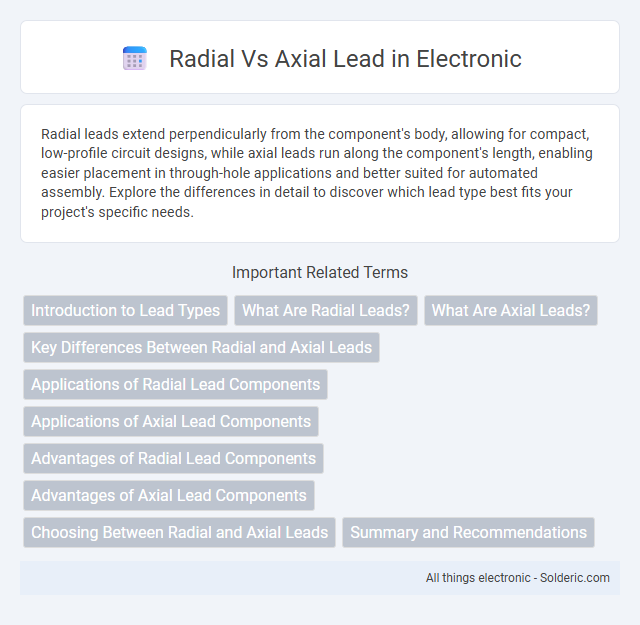Radial leads extend perpendicularly from the component's body, allowing for compact, low-profile circuit designs, while axial leads run along the component's length, enabling easier placement in through-hole applications and better suited for automated assembly. Explore the differences in detail to discover which lead type best fits your project's specific needs.
Comparison Table
| Feature | Radial Lead | Axial Lead |
|---|---|---|
| Lead Orientation | Leads extend from the same side (bottom) | Leads extend from opposite ends (sides) |
| Common Use | Vertical mounting on PCBs | Horizontal mounting on PCBs |
| Space Efficiency | More compact footprint | Occupies more PCB space lengthwise |
| Mechanical Stability | Less mechanical stress on leads | More mechanical stability in axial direction |
| Typical Components | Capacitors, small inductors | Resistors, diodes, capacitors |
| Assembly Convenience | Easier automated insertion | Better for manual assembly |
Introduction to Lead Types
Radial and axial lead components differ primarily in the orientation of their leads relative to the body of the component, impacting circuit board layout and assembly efficiency. Radial leads extend perpendicularly from the component, making them ideal for compact, space-saving designs, while axial leads run parallel, suitable for through-hole applications requiring easy insertion and automated soldering. Understanding these lead types helps optimize your electronic design's reliability and manufacturing process.
What Are Radial Leads?
Radial leads are wire terminals that extend outward from the same side of a cylindrical electronic component, such as capacitors or resistors, allowing for compact and stable mounting on printed circuit boards (PCBs). These leads make your assembly process more efficient by minimizing the component's footprint and facilitating automated insertion. Choosing radial leads can enhance circuit reliability by providing better mechanical stability compared to axial leads in specific layouts.
What Are Axial Leads?
Axial leads refer to wire terminals that extend from both ends of a cylindrical electronic component, such as resistors, capacitors, or diodes, allowing them to be mounted flush with a circuit board. These leads enable a streamlined, horizontal orientation, which conserves board space and facilitates automatic insertion in through-hole assembly processes. Axial lead components are preferred in applications requiring easy replacement and reliable mechanical stability in compact electronic designs.
Key Differences Between Radial and Axial Leads
Radial leads extend perpendicularly from the component body, allowing for compact vertical mounting on printed circuit boards (PCBs), while axial leads run parallel along the component's length, facilitating horizontal placement. Radial lead components typically occupy less PCB surface area, ideal for space-saving designs, whereas axial leads offer easier insertion and alignment in through-hole mounting. Electrical performance remains comparable, but the choice impacts assembly efficiency, mechanical sturdiness, and overall circuit layout optimization.
Applications of Radial Lead Components
Radial lead components are commonly used in compact electronic devices due to their ability to fit efficiently on printed circuit boards, optimizing space in applications such as power supplies, signal processing circuits, and consumer electronics. Their stable mounting and shorter lead length enhance mechanical strength, making them ideal for high-vibration environments like automotive and industrial equipment. Your choice of radial leads ensures reliable performance in densely packed assemblies where durability and compactness are critical.
Applications of Axial Lead Components
Axial lead components are widely utilized in applications requiring easy insertion into printed circuit boards (PCBs) and streamlined assembly processes, such as in power supplies, automotive electronics, and telecommunications equipment. Their linear lead configuration supports automated soldering and wave soldering techniques, making them ideal for mass production environments. These components excel in circuits where space constraints require compact, aligned mounting without compromising performance or reliability.
Advantages of Radial Lead Components
Radial lead components offer a compact design with leads extending from the same side, enabling efficient use of board space and simplified automated assembly in PCB manufacturing. Their symmetrical lead placement enhances mechanical stability and improves thermal performance due to uniform heat dissipation. Using radial lead components can optimize your circuit layout by reducing trace lengths and minimizing parasitic inductance, resulting in improved electrical performance.
Advantages of Axial Lead Components
Axial lead components offer advantages such as easier insertion into through-hole PCBs due to their straight leads, enabling faster automated assembly and efficient use of board space. Their symmetrical design provides stable mechanical support, improving durability in applications with vibration or mechanical stress. You benefit from simplified troubleshooting and component replacement, as axial components are straightforward to identify and handle during maintenance.
Choosing Between Radial and Axial Leads
Choosing between radial and axial leads depends on the circuit design and space constraints; radial leads, with their compact footprint, suit densely populated PCBs while axial leads offer easier insertion and better mechanical stability in through-hole assemblies. Radial lead components are ideal for surface-mount applications requiring low profile, whereas axial leads excel in applications demanding straightforward orientation and robust mounting. Evaluating factors like lead spacing, orientation, and intended mechanical stress helps select the appropriate lead style for reliable electronic performance.
Summary and Recommendations
Radial leads offer a compact footprint and strong mechanical stability, making them ideal for high-density circuit boards and automated assembly processes. Axial leads provide straightforward through-hole mounting with ease of component replacement, suitable for prototyping and low-volume production. Choose radial leads for space-saving designs and enhanced durability, while axial leads are recommended for applications requiring simpler layout or frequent maintenance.
Radial vs Axial Lead Infographic

 solderic.com
solderic.com